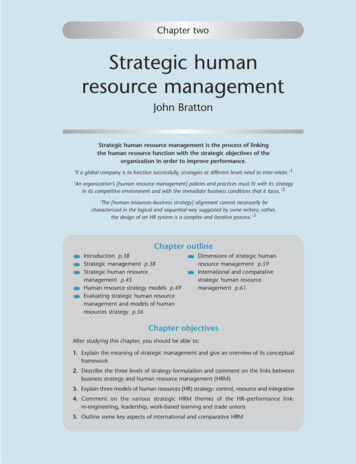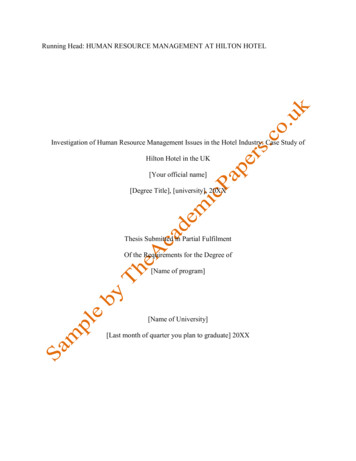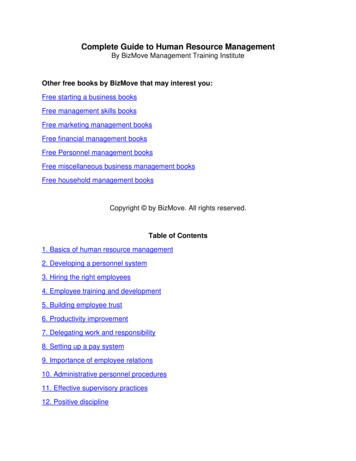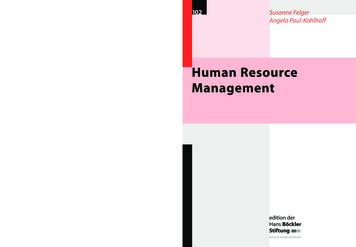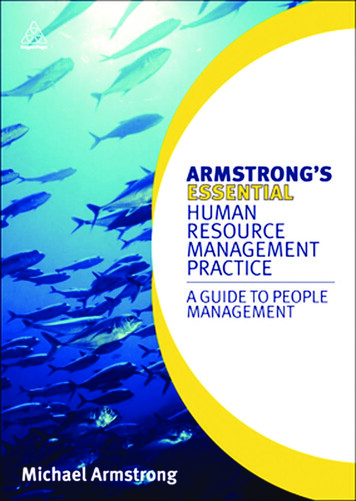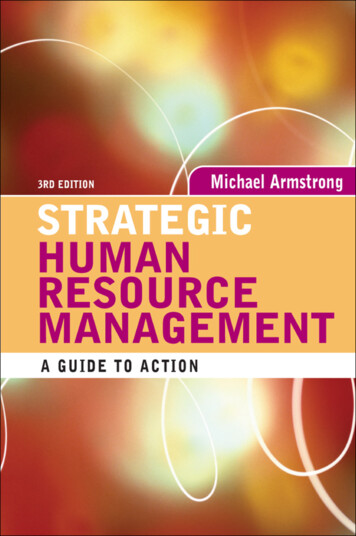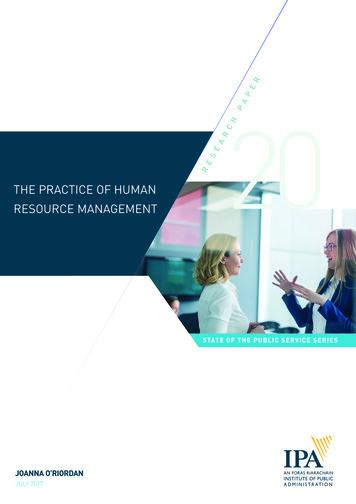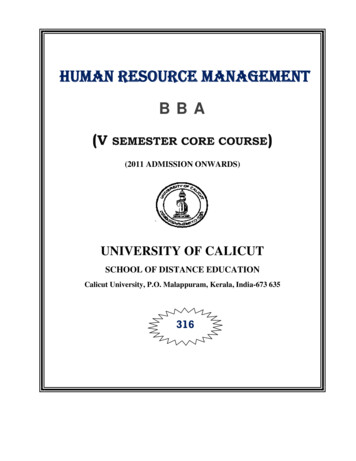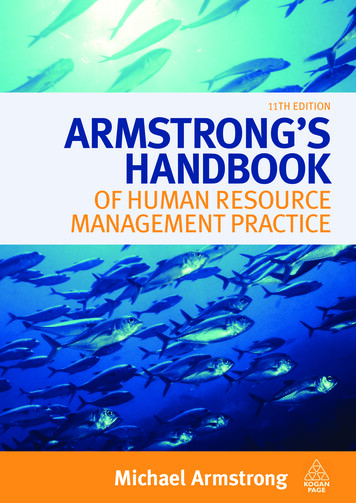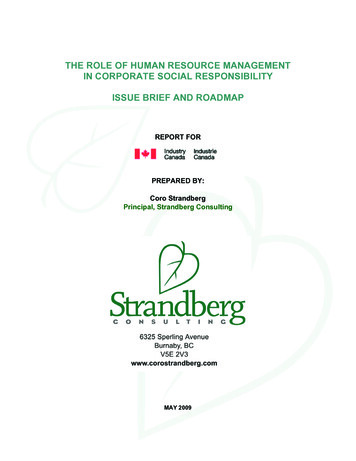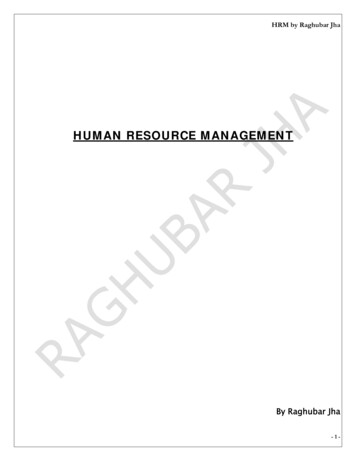
Transcription
HRM by Raghubar JhaHUMAN RESOURCE MANAGEMENTBy Raghubar Jha-1-
HRM by Raghubar JhaToMy ParentsWho taught me the first lesson ofHuman Resource Management-2-
HRM by Raghubar JhaINDEXHUMAN RESOURCE MANAGEMENT ( H R M ) . 4STRATEGIC HUMAN RESOURCE MANAGEMENT: - . 8HUMAN RESOURCE DEVELOPMENT . 9TEAM EFFECTIVENESS. 10HUMAN RESOURCE PLANNING ( H R P ) . 12JOB ANALYSIS . 19JOB DESCRIPTION .22JOB SPECIFICATION . 23JOB EVALUATION. 23JOB DESIGN . 24DESIGNING JOBS – MOTIVATING JOBS . 26JOB SATISFACTION. 27WORK SAMPLING. 28RECRUITMENT & SELECTION . 29TRAINING & DEVELOPMENT . 32INDUCTION & ORIENATION. 37CHANGE MANAGEMENT. 39PERFORMANCE APPRAISALS. 44INCENTIVES BASED COMPENSATION . 50HUMAN RESOURCE AUDIT. 51MOTIVATION THEORIES . 52MORALE. 54PERSONNEL POLICIES . 54WORKERS’ PARTICIPATION IN MANAGEMENT . 55UNIONS . 56ORGANIZATIONAL DOWNSIZING. 58MEANING OF ORGANIZATION STRUCTURE . 58-3-
HRM by Raghubar JhaHUMAN RESOURCE MANAGEMENT ( H R M )D ef in i tion 1 – I n t e g r ati on“HRM is a series of integrated decisions that form the employment relationships; their quality contributesto the ability of the organizations and the employees to achieve their objectives.”D ef in i tion 2 – I nflu en cing“HRM is concerned with the people dimensions in management. Since every organization is made up ofpeople, acquiring their services, developing their skills, motivating them to higher levels of performanceand ensuring that they continue to maintain their commitment to the organization are essential toachieving organizational objectives. This is true, regardless of the type of the organization – government,business, education, health, recreational, or social action.”D ef in i tion 3 – Appl icabil ity“HRM planning, organizing, directing and controlling of the procurement, development, compensation,integration, maintenance and separation of human resources to the end that individual, organizational andsocial objectives are accomplished.”MEANING OF HRM: HRM is management function that helps managers to recruit, select, train and develop members for anorganization. Obviously HRM is concerned with the people’s dimensions in organizations. HRM refers to setof programs, functions, and activities designed and carried outCo re e leme nt s o f HR M People: Organizations mean people. It is the people who staff and manage organizations. Manag eme nt : HRM involves application of management functions and principles for acquisitioning,developing, maintaining and remunerating employees in organizations. I n teg ra t ion & C o ns i st e n cy : Decisions regarding people must be integrated and consistent. I n f lu e n ce : Decisions must influence the effectiveness of organization resulting into betterment ofservices to customers in the form of high quality products supplied at reasonable cost. App l ica bil i ty : HRM principles are applicable to business as well as non-business organizations too,such as education, health, recreation and the like.OBJECTIVES OF HRM: 1. Societal Objectives: To be ethically and socially responsible to the needs and challenges of thesociety while minimizing the negative impact of such demands upon the organization.2. O rg a n iz a t io na l Ob je c tiv es: To recognize the role of HRM in bringing about organizationaleffectiveness. HRM is only means to achieve to assist the organization with its primary objectives.3. F u n ct io na l O b j ec ti v es : To maintain department’s contribution and level of services at a levelappropriate to the organization’s needs.4. Personal Obje ct ives: To assist employees in achieving their personal goals, at least in so far asthese goals enhance the individual’s contribution to the organization. This is necessary to maintainemployee performance and satisfaction for the purpose of maintaining, retaining and motivating theemployees in the organization.SC OPE OF HR M: From Entry to the Exit of an employee in the organization-4-
HRM by Raghubar JhaScope of HRM can be described based on the following activities of HRM. Based on these activities we cansummarize the scope of HRM into 7 different categories as mentioned below after the activities. Lets checkout both of them.H R M A c t iv it ie s –1. HR Planning2. Job Analysis3. Job Design4. Recruitment & Selection5. Orientation & Placement6. Training & Development7. Performance Appraisals8. Job Evaluation9. Employee and Executive Remuneration10. Motivation11. Communication12. Welfare13. Safety & Health14. Industrial Relations7 Ca tegories of Scope of HR M1. Introduction to HRM2. Employee Hiring3. Employee and Executive Remuneration4. Employee Motivation5. Employee Maintenance6. Industrial Relations7. Prospects of HRMROLE OF HRM1. Advisory Role: HRM advises management on the solutions to any problems affecting people,personnel policies and procedures.a.Personnel Policies: Organization Structure, Social Responsibility, Employment Terms &Conditions, Compensation, Career & Promotion, Training & Development and Industrial Relations.b.Personnel Procedures: Relating to manpower planning procedures, recruitment and selectionprocedures, and employment procedures, training procedures, management development procedures,performance appraisal procedures, compensation procedures, industrial relations procedures and healthand safety procedures.2. Functional Role: The personnel function interprets and helps to communicate personnel policies. Itprovides guidance to managers, which will ensure that agreed policies are implemented.3. Service Role: Personnel function provides services that need to be carried out by full time specialists.These services constitute the main activities carried out by personnel departments and involve theimplementation of the policies and procedures described above.Role of HR Managers (Today)1. Humanitarian Role: Reminding moral and ethical obligations to employees2. Counselor: Consultations to employees about marital, health, mental, physical and career problems.-5-
HRM by Raghubar Jha3. Mediator: Playing the role of a peacemaker during disputes, conflicts between individuals and groupsand management.4. Spokesman: To represent of the company because he has better overall picture of his company’soperations.5. Problem Solver: Solving problems of overall human resource management and long-termorganizational planning.6. Change Agent: Introducing and implementing institutional changes and installing organizationaldevelopment programs7. Management of Manpower Resources: Broadly concerned with leadership both in the group andindividual relationships and labor-management relations.Role of HR Managers (Future)1.2.3.4.5.6.7.Protection and enhancement of human and non-human resourcesFinding the best way of using people to accomplish organizational goalsImprove organizational performanceIntegration of techniques of information technology with the human resourcesUtilizing behavioral scientists in the best way for his peopleMeeting challenges of increasing organizational effectivenessManaging diverse workforceFU NCT IONS OF HR M A LONG WITH O BJ ECT IVE SHRM ObjectivesSocial Objectives (3)Organizational Objectives (7)Functional Objectives (3)Personal Objectives (5)Supporting HRM FunctionsLegal ComplianceBenefitsUnion Management RelationsHuman Resource PlanningEmployee RelationsRecruitment & SelectionTraining & DevelopmentPerformance AppraisalsPlacement & OrientationEmployee AssessmentPerformance AppraisalsPlacement & OrientationEmployee AssessmentTraining & DevelopmentPerformance AppraisalsPlacement & OrientationCompensationEmployee AssessmentManag eria l F unctions of HR M1. Planning: Plan and research about wage trends, labor market conditions, union demands and otherpersonnel benefits. Forecasting manpower needs etc.2. Organizing: Organizing manpower and material resources by creating authorities and responsibilitiesfor the achievement of organizational goals and objectives.3. Staffing: Recruitment & Selection4. Directing: Issuance of orders and instructions, providing guidance and motivation of employees tofollow the path laid-down.5. Controlling: Regulating personnel activities and policies according to plans. Observations andcomparisons of deviations-6-
HRM by Raghubar JhaO pera t iona l Fun c ti on s of HR M1. Procurement: Planning, Recruitment and Selection, Induction and Placement2. Development: Training, Development, Career planning and counseling.3. Compensation: Wage and Salary determination and administration4. Integration: Integration of human resources with organization.5. Maintenance: Sustaining and improving working conditions, retentions, employee communication6. Separations: Managing separations caused by resignations, terminations, lay offs, death, medicalsickness etc.CH ALLE NGES OF HR M I N I ND IAN ECO NO MY or C HA LLENGES OF MODE RNMANAGEMENT1. Globalizatio n: - Growing internationalization of business has its impact on HRM in terms ofproblems of unfamiliar laws, languages, practices, competitions, attitudes, management styles, workethics and more. HR managers have a challenge to deal with more functions, more heterogeneousfunctions and more involvement in employee’s personal life.2. Co rpo rate Re -organ iza tio ns : - Reorganization relates to mergers and acquisitions, jointventures, take over, internal restructuring of organizations. In these situations, it is difficult to imaginecircumstances that pose a greater challenge for HRM than reorganizations itself. It is a challenge tomanage employees’ anxiety, uncertainties, insecurities and fears during these dynamic trends.3. New Organ iza tio na l for ms : - The basic challenge to HRM comes from the changing characterof competitions. The competition is not between individual firms but between constellations of firm. Majorcompanies are operating through a complex web of strategic alliances, forgings with local suppliers, etc.These relationships give birth to completely new forms of organizational structure, which highly dependupon a regular exchange of people and information. The challenge for HRM is to cope with the implicationsof these newly networked relations more and more, in place of more comfortable hierarchical relationshipsthat existed within the organizations for ages in the past.4. C ha ng ing Demog ra p hi cs of W or kf orc e : - Changes in workforce are largely reflected by dualcareer couples, large chunk of young blood between age old superannuating employees, working mothers,more educated and aware workers etc. These dynamic workforces have their own implications for HRmanagers and from HRM point of view is a true challenge to handle.5. C hang ed em ploy ee exp ecta tio ns: - With the changes in workforce demographics, employeeexpectations and attitudes have also transformed. Traditional allurements like job security, house, andremunerations are not much attractive today, rather employees are demanding empowerment andequality with management. Hence it is a challenge for HRM to redesign the profile of workers, anddiscover new methods of hiring, training, remunerating and motivating employees.6. New I ndu s tr ial Re la tio ns Appr oach : - In today’s dynamic world, even unions haveunderstood that strikes and militancy have lost their relevance and unions are greatly affected by it. Thetrade union membership has fallen drastically worldwide and the future of labor movement is in danger.The challenge before HRM is to adopt a proactive industrial relations approach which should enable HRspecialist to look into challenges unfolding in the future and to be prepared to convert them intoopportunities.7. Renewed Peop le Fo cus: - The need of today’s world and business is the people’s approach. Thestructure, strategy, systems approach which worked in post war era is no more relevant in today’s-7-
HRM by Raghubar Jhaeconomic env
Management of Manpower Resources: Broadly concerned with leadership both in the group and individual relationships and labor-management relations. Role of HR Managers (Future) 1. Protection and enhancement of human and non-human resources 2. Finding the best way of using people to accomplish organizational goals 3. Improve organizational .

